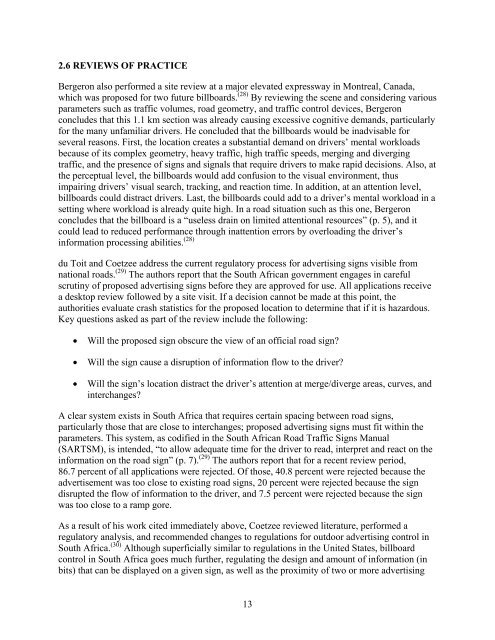The Effects of Commercial Electronic Variable Message Signs ...
The Effects of Commercial Electronic Variable Message Signs ...
The Effects of Commercial Electronic Variable Message Signs ...
Create successful ePaper yourself
Turn your PDF publications into a flip-book with our unique Google optimized e-Paper software.
2.6 REVIEWS OF PRACTICE<br />
Bergeron also performed a site review at a major elevated expressway in Montreal, Canada,<br />
which was proposed for two future billboards. (28) By reviewing the scene and considering various<br />
parameters such as traffic volumes, road geometry, and traffic control devices, Bergeron<br />
concludes that this 1.1 km section was already causing excessive cognitive demands, particularly<br />
for the many unfamiliar drivers. He concluded that the billboards would be inadvisable for<br />
several reasons. First, the location creates a substantial demand on drivers’ mental workloads<br />
because <strong>of</strong> its complex geometry, heavy traffic, high traffic speeds, merging and diverging<br />
traffic, and the presence <strong>of</strong> signs and signals that require drivers to make rapid decisions. Also, at<br />
the perceptual level, the billboards would add confusion to the visual environment, thus<br />
impairing drivers’ visual search, tracking, and reaction time. In addition, at an attention level,<br />
billboards could distract drivers. Last, the billboards could add to a driver’s mental workload in a<br />
setting where workload is already quite high. In a road situation such as this one, Bergeron<br />
concludes that the billboard is a “useless drain on limited attentional resources” (p. 5), and it<br />
could lead to reduced performance through inattention errors by overloading the driver’s<br />
information processing abilities. (28)<br />
du Toit and Coetzee address the current regulatory process for advertising signs visible from<br />
national roads. (29) <strong>The</strong> authors report that the South African government engages in careful<br />
scrutiny <strong>of</strong> proposed advertising signs before they are approved for use. All applications receive<br />
a desktop review followed by a site visit. If a decision cannot be made at this point, the<br />
authorities evaluate crash statistics for the proposed location to determine that if it is hazardous.<br />
Key questions asked as part <strong>of</strong> the review include the following:<br />
• Will the proposed sign obscure the view <strong>of</strong> an <strong>of</strong>ficial road sign?<br />
• Will the sign cause a disruption <strong>of</strong> information flow to the driver?<br />
• Will the sign’s location distract the driver’s attention at merge/diverge areas, curves, and<br />
interchanges?<br />
A clear system exists in South Africa that requires certain spacing between road signs,<br />
particularly those that are close to interchanges; proposed advertising signs must fit within the<br />
parameters. This system, as codified in the South African Road Traffic <strong>Signs</strong> Manual<br />
(SARTSM), is intended, “to allow adequate time for the driver to read, interpret and react on the<br />
information on the road sign” (p. 7). (29) <strong>The</strong> authors report that for a recent review period,<br />
86.7 percent <strong>of</strong> all applications were rejected. Of those, 40.8 percent were rejected because the<br />
advertisement was too close to existing road signs, 20 percent were rejected because the sign<br />
disrupted the flow <strong>of</strong> information to the driver, and 7.5 percent were rejected because the sign<br />
was too close to a ramp gore.<br />
As a result <strong>of</strong> his work cited immediately above, Coetzee reviewed literature, performed a<br />
regulatory analysis, and recommended changes to regulations for outdoor advertising control in<br />
South Africa. (30) Although superficially similar to regulations in the United States, billboard<br />
control in South Africa goes much further, regulating the design and amount <strong>of</strong> information (in<br />
bits) that can be displayed on a given sign, as well as the proximity <strong>of</strong> two or more advertising<br />
13

















